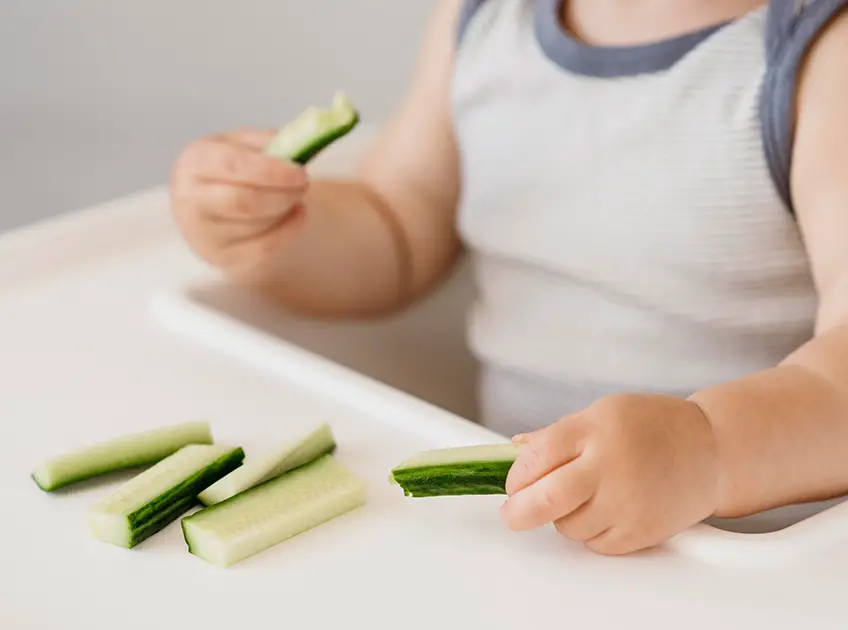
Important: This article is for informational purposes only. Please read our full disclaimer for more details.
Baby-led weaning is an alternative feeding method reintroduced in the UK more than a decade ago. In this feeding technique, a baby begins complementary feeding by self-feeding instead of spoon-feeding. It means that the baby skips commercial baby foods and purees and directly begins eating bite-sized, solid food items independently with their hands.
Most babies can start baby-led weaning from six months of age, but some may take longer. Experts have been debating this feeding technique due to the associated risks, such as choking. Read this post to know more about baby-led weaning, its pros and cons, and tips for successful and safe baby-led weaning.
Benefits of Baby-Led Weaning (BLW)
Baby-led weaning allows your baby to touch, smell, and taste the food independently, thus honing their sensory skills. Besides, supervised baby-led weaning may help your baby in.
1. Reducing Picky Eating Habits that make a baby eat certain types of food and reject others. Although fussy eating isn’t always a concern, it raises the risk of nutrient deficiencies, which can have long-term health effects.
2. Making feeding easier for parents and caregivers as baby-led weaning lets the baby control what they eat and how much they eat. It also takes off the extra effort of preparing purees. Parents can serve what they are eating in minced and chopped forms to their baby for self-feeding.
3. Understanding and regulating hunger and satiety cues, allowing them to decide what, how much, and how quickly to eat. It makes the infant an active partner in the feeding process and not a passive recipient. According to experts, self-regulation of feeding could help a baby eat adequately and prevent chronic health issues, such as excessive weight gain.
4. Fine-tuning oral motor skills by letting babies chew and move food of different textures inside the mouth from an early age. Most babies develop teeth between six and 12 months, and it is when baby-led weaning can help babies bite foods and support their teething process.
5. Developing motor skills by letting children pick and hold foods of different textures, shapes, and sizes. Picking food requires a baby to use their fingers (pincer grasp) and palm (palmar grasp). Bringing the food to their mouth exercises the baby’s eye-hand coordination and dexterity.
6. Inculcating healthy food choices wherein the baby selects foods based on their type and texture, not solely on taste. It exposes the baby to various healthy foods, such as fruits and vegetables. It also helps a baby develop healthy eating habits from an early age and reap long-term health benefits.
What Are The Concerns With Baby-Led Weaning?
Even supervised baby-led weaning could pose some risks that parents should know to make informed choices.
1. Negative Mealtime Experience
Gagging is a vital reflex that prevents choking in babies. A baby can experience gagging during the initial stages of baby-led weaning. It can scare some babies and may instill negative mealtime experiences, making a baby quit self-feeding. This is almost always a temporary phenomenon.
2. Inadequate Nutrient Intake
Some studies highlight that baby-led weaning could increase the risk of insufficient nutrient intake. Babies are at a higher risk for iron, zinc, and vitamin B1 deficiencies, which can lead to growth and development issues over time. However, more research is required to confirm the findings.
Also there is no rule book which says that you cannot feed the baby once they are done with playing and eating on their own. Try feeding them with a spoon or hand after the baby displays cues that she or he is done with self feeding for the time being. But again respect their wishes and under no circumstances should you force-feed them.
3. Risk of Choking
Babies at six months of age are still developing oral motor skills, exposing them to the risk of choking even when fed lumpy foods with a spoon. Research highlights that there is no difference in choking incidence between babies weaned using the baby-led weaning and traditional weaning method. Yet, it is preeminent to ensure that the baby is developmentally ready to begin eating independently.
Besides these risks, unsupervised baby-led weaning exposes a baby to different foods at a time, making it challenging to determine the allergen if the baby has an allergic reaction.
How To Begin Baby-Led Weaning (BLW)?
Baby-led weaning doesn’t need any particular arrangement. However, it does require you to follow some simple tips to start safely.
- Adjust the baby to a comfortable position and choose an appropriate place, such as a high chair or your lap. Ensure the baby is seated straight and not leaning forward. Also, the baby should be able to move their arms and hands freely.
- Turn off those screens: Your baby is learning a new skill. Televisions, mobiles, tablets are not just distractions but they effectively switch off your baby’s thought process. So basically the baby no longer knows what she or he is eating, the taste, color, texture, appearance of food being consumed, how their family is eating, is she or he hungry or satisfied. This is true for children of all ages and even adults so always switch off screens during meals in order to make the most out of them.
- Offer food in age-appropriate size and texture. Some of the foods that babies can self-feed are minced, chopped, or bite-sized chunks of baked or boiled skinless sweet potato, carrot, and potato wedges. Some of the other food items that you can consider are thin banana or mango slices, mashed beans, shredded fish, tofu, chunks of hard-boiled egg, and mashed meat.
- Serve food in an unbreakable bowl or plate. You can also use an anti-skid mat or a suction bowl. Place a small cup of water that the baby can sip in between.
- Make meal times fun times: Serve food in colorful plates and bowls. Use your imagination – bowls made from watermelon or musk melon, coconut kernels as small bowls, plates made from banana leaves are just some ideas to begin with. You can have an underlying theme for any meal eg. all courses of the meal should contain coconut (start with a thai soup and end with a coconut pudding). Meal platters should not become battlegrounds between your dominance and the baby’s natural urge for independence.
- Start slowly and give your baby ample time to self-feed. In the beginning, the process may be messy, but it will improve as the baby hones their self-feeding skills.
- Let the baby divide what and how much they intend to eat. Initially, the baby will not eat much and instead will explore food. They will gradually consume food and adjust their appetite in sync with their breast milk or formula intake.
- Set the right examples and eat healthy food. Babies mimic adults. Help them learn healthy eating habits and serve them healthy foods that you eat yourselves.
If you are considering baby-led weaning, be aware of the concerns associated with it.
When Should You Start Baby-Led Weaning (BLW)
Baby-led weaning, also known as auto-weaning, doesn’t start suddenly. As a parent, you need to look for signs of readiness. A baby is ready to self-wean, under supervision, when they:
- Can sit straight without support.
- Can hold their neck and head straight.
- Show interest in eating food that others are eating.
- Can pick up food, hold it, and put it in their mouth.
- Can move the food from the front of the mouth to the back with jaw movements.
Most babies develop these abilities by six months of age, but some may take longer. Depending on the signs of readiness, you can try baby-led weaning for your baby.
Tips For Successful Baby-Led Weaning (BLW)
If you wish to try baby-led weaning for your baby, the following tips may help.
1. Never leave a baby unattended while they are self-feeding. It is necessary to prevent the risk of choking.
2. Put a bib on your baby before they start feeding. Ensure the bib is big enough to cover them up to the tummy as babies often spill food while trying self-feeding.
3. Continue feeding breast milk or formula with complementary foods. Breastfeeding or formula feeding should continue up to the age of 12 months, even when the baby is eating solid food. Breastfeeding can continue through toddler hood, depending on the choice of the toddler and the mother.
4. Avoid baby self-feeding when they are too hungry. It will make a baby eat more food at a time and swallow fast, resulting in gagging or choking. You may nurse your an hour earlier so that their tummy is partially full and they self-feed slowly.
5. Understand the difference between choking and gagging. It will help you take suitable practical care tips whenever needed.
6. Give various seasonal foods across meals. The gradual introduction of foods can help a baby adjust to a particular food. It will also help rule out any allergies or intolerances, just like you would do while spoon-feeding.
7. Offer foods cut in bite-sized pieces or chunks but ensure they aren’t too small to pick. Some babies may grow irritated if they cannot pick their food, making them lose interest and appetite.
8. Serve only a few pieces of food at a time. Giving too many pieces or giving different foods at once can overwhelm some babies.
9. Avoid serving foods that are potential choking hazards. Whole nuts, cherries, whole grapes, and apple slices with skin can choke a baby as the baby can’t break them into smaller pieces themselves.
10. Try a mixed approach wherein you can let the baby self-feed in combination with spoon- feeding. The foods that you can spoon-feed your baby are iron-fortified cereals, pureed meat, and mashed vegetables. These foods are good sources of iron, protein, and other vital nutrients.
11. Stay alert to signs of allergy. Hives, skin rash, swelling of the mouth, wheezing, vomiting, nausea or vomiting, and diarrhea are some of the common signs of allergy.
12. Be patient and diligent. Baby-led weaning can be messy, requiring you to be patient and supportive to your baby. You can involve your partner or other family members to share responsibilities and supervise a baby while they self-feed.
13. Make mealtimes fun. Baby-led weaning is all about exploring foods and enjoying their taste. So, let your baby eat and play a little with food. As a parent, you would like to discipline them around food. However, do not be too particular about it since your little one will gradually learn table manners as they grow older.
14. Do not force your baby to learn self-feeding as you would expect them to. Every baby is different and unique in its way of grasping things. Be supportive and help them understand the basics of self-feeding.
Baby led feeding has evolved for thousands of years along with the evolution of the human race. It has not just stood the test of time but has continued to modify itself in such a way that it is the most adept way to not just fulfill the nutritional requirements but also physical and emotional needs of growing humans.
You Might Also Like:
- Lovies For Babies: Safety, How And When To Introduce Them
- 10 Things I Wish I Knew Before Becoming A Mother
- How to Swaddle a Baby: How To Do It And Benefits
- Baby Wearing: Benefits, Safety Tips, and How To
- Top 10 Fun Ways To Tell Your Family You’re Pregnant
- Seventh Generation Baby Diapers Review
- 30 Amazing Footprint Tattoo Ideas You’ll Love
- Baby Elimination Communication: How To Do It And Benefits
- 35+ Cutest Baby Shower Nail Art Ideas
- 3 Health Benefits Of Dry Fruits During Pregnancy
Image Credit: freepik















